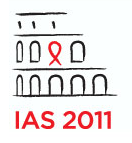Hearing loss not associated with HIV in MACS and WIHS cohorts
1 August 2011. Related: Conference reports, Side effects, Coinfections and complications, IAS 6th Rome 2011.
 Simon Collins, HIV i-Base
Simon Collins, HIV i-Base
Hearing loss has been associated as a complication in HIV-positive people but it is unclear whether HIV is a direct factor or whether symptoms are more strongly correlated to risk factors reported in the general population. This will be increasingly important as the HIV population ages.
Researchers from Washington DC measured cochlear function in 334 men and 178 women from two of the earliest population cohorts established to look at differences between HIV-positive and HIV-negative patients (MACS and WIHS respectively), and related to this to social factors including noise exposure and HIV and treatment history.
The mean age was 54 years for the men (46% were HIV-positive), and 45 years for the women (77% were HIV-positive). People were excluded if they had hearing-impaired clinical symptoms or recent use of orotoxic medication. Approximately 20% of people in each of the HIV-positive and HIV negative groups self-reported exposure to occupational noise.
Cochlear function was measured by distortion product otoacoustic emission (DPOAE) testing which is a non-invasive procedure using two separate tones to stimulate the cochlea. Each ear was measured twice, with a third test if results were inconsistent and the number of non-responses added as an outcome variable (0-4).
In multivariate analyses, a 10-year increase in age [OR 2.78; 95%CI 2.07, 3.73], being male [OR 5.60; 95%CI 2.98, 10.49], and being non-black [OR 2.75; 95%CI 1.57, 4.83] were significantly associated with a higher number of non-responses (all p<0.001), but not HIV status [OR 1.20; 95%CI 0.7, 2.02; p =0.52 NS]. However, neither occupational or non-occupational noise exposure was associated with reduced function (p=0.33 and p=0.93, respectively).
Age, race, and gender remained significant risk factors for increasing non-responses in the HIV-positive model. However, none of the HIV-related factors including use of monotherapy, combination therapy, HAART use, 100-cell increase in peak CD8, HIV viral load, and 100-cell increase in nadir CD4 count came near approaching statistical significance (with p-values ranging from 0.2 to 0.7).
The researchers concluded that HIV status, combination therapy, nadir CD4 count, peak CD8 count, and HIV viral load did not significantly predict decreased cochlear function in this patient group.
Reference
Torre P et al. Cochlear function among Multicenter AIDS Cohort Study (MACS) and Womens Interagency HIV Study (WIHS) participants. 16th IAS Conference on HIV Pathogenesis, Treatment and Prevention, 17–20 July 2011, Rome. Poster abstract TUPE138. Poster. (PDF)

